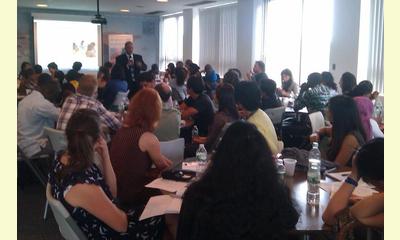|
|
Let’s go to school! The UNAOC Summer school
un articulo por Marcos Estrada
What a school! In the middle of summer, on 29th of
August 2013, I visited a school many people would
like to go to and nobody is complaining to go
there over the summer. In fact, many people,
including myself, would like to take part in it!!
I am talking about the United Nations Alliance of
Civilisations (UNAOC) Summer School, held between
24th and 31st of August, in Tarrytown, in New York
City area.

click on photo to enlarge
When arriving at the place, it was easy to see it
was a different kind of school. At the entrance I
noticed people from different countries speaking
different languages amongst themselves. After
hearing that there were 100 participants from
different countries, I was no longer surprised.
The day promised to be a nice experience, and it
was!
As soon as I entered the room where the first
activity of the day was being held, David and I
were greeted by participants and people helping in
the summer school. The day started rocking, after
seeing our old friends Meg Villanueva and Shreya
Jani. We sat down and participated in the first
activity of the day. It was Meg’s and Chris
Dekki's session on “Effective Advocacy: Strategy
for Social Work”, it was just the warm up for
Meg’s second session All the Pieces if Peace, just
after lunch.
The big “WOW” in the school was the experience of
the participants, they were all working in
different areas, with different objectives, in
different parts of the world, but all cultivating
a Culture of Peace. Talking with them during the
day, I was impressed by the different experiences
and how they deal with them. And at the end of
the day when the participants prepared a showcase
to share their work, it was a great opportunity to
know more about their work and how I could get
engaged with them.
Here are just a few of the one hundred examples.
The Argentinean participant Ines Finchelstein
created "La Revistita Multicultural" (www.la-
revistita.com.ar) that has already about 1000
children to become agents of change by producing
material on their cultural heritage. From the
other side of the world came Shreya Jani, founder
and trustee of Standing Together to Enable Peace
Trust (India). She is a peace educator working at
the grassroots level, as well as having co-
authored books with the renowned Vandana Shiva.
We also met Salome from the Republic of Georgia
who works on the strategy for sustainable
Development in the youth organization Regional
Development Network and the social entrepreneur
Tere from Mexico who provides ecologically and
sustainable sources of light at a low cost.
My day at the school was an enriching joyful
experience. Youth from around the world should
hold hands together and build a better future for
all. I want to take part in it.
|








|
DISCUSSION
Pregunta(s) relacionada(s) al artículo :
Is there a renewed movement of solidarity by the new generation?,
* * * * *
Comentario más reciente:
from Javier Collado Ruano, Director of Edition at Global Education Magazine, on the occasion of the International Day of Solidarity.
Solidarity is a trans-dimensional phenomenon that goes beyond the ontological essence of human nature. In fact, when we analyze the connections between the microcosm and the macrocosm, we perceive that human beings are not involved in chaos and arbitrariness, but belongs to the large network of interdependencies, complementarities and reciprocities that constitute life. The emergence of life on Earth, around 3,8 billion years ago, was a complex process of exceptional natural phenomena, inherent in all living systems. A process which is expressed through unlimited creativity: mutation, gene exchange, and symbiosis. From a cosmo-biological perspective, we can understand a new conceptual dimension of life, where all living beings share same basis of genetic code: the twenty amino-acids and four phosphatic bases. In fact, the diversity of living beings is caused by the combination of this cosmo-bio-genetic basis.
This trans-dimensional perspective has a deep ecological and spiritual sense for our worldview because the human evolutionary adventure is the latest stage of life on Earth. The modern human being is a vertebrate animal, mammal, belonging to the primates, which emerged 200,000 years ago. In recent centuries he has imposed its anthropocentric, industrial and capitalist vision to the detriment of Pachamama (and Indigenous goddess known as earth mother). We consume around 120% of the natural resources that Earth Mother regenerats annually. Our consumer behavior is immersed in a fatalistic dynamic with a destiny to climate change (deforestation, loss of biodiversity, ozone, etc.), and our own self-destruction as a species.
There is an urgent need to get beyond the cognitive fallacy that the mental structures of social Darwinism and capitalist postulates of the 19th century have historically constituted, because they only understand natural and social systems as warmongers and competitive processes whereby species diverge from each other. . ... continuación.

|
|









